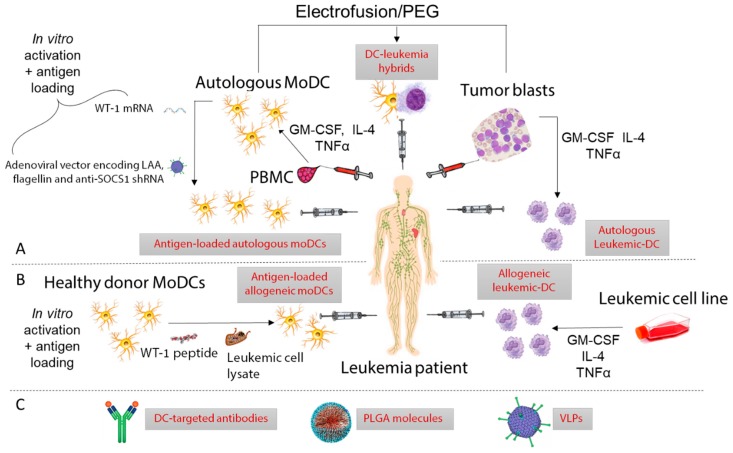Figure 4.
Summary of recent clinical trials and preclinical vaccination strategies utilizing dendritic cells to vaccinate leukemia patients. (A) Ex vivo autologous approaches: Autologous moDC derived in remission from patient PBMC have been used extensively in AML patients with the aim of preventing relapse. Promising results have been obtained by Wang and van Tendeloo et al. by loading DCs with WT-1 mRNA [105,113] or transfecting them with modified adenovirus [105]. Leukemic-DC have also been used by Westermann and Ossenkoppele et al. by isolating patient blasts and maturing to DC with cytokines [87,88]. Autologous hybrids fused using polyethylene glycol (PEG) or electroporation combining the antigen-presenting capacity of moDC with the neoantigen repertoire of leukemic blasts have been tested by Rosenblatt et. al, achieving exciting clinical results [100]. (B) Ex vivo allogeneic approaches: Allogeneic moDC derived from healthy donors and loaded with tumor cell lysate or WT-1 peptide have been used by Hus and Shah et al. [95,108]. Promising results have been achieved by van Loosdrecht et al. who matured an AML cell line with cytokines to allogeneic AML-DC before injection into AML patients [93]. (C) Several vaccination strategies exist for targeting DCs in vivo. Zhang et al. were able to induce an immune response in vitro using WT-1 loaded PLGA molecules which were phagocytosed by DCs [142], and Griffiths et al. induced immune responses in AML patients vaccinated with DEC-205 antibodies [137]. Virus-like particles (VLPs) are yet to be tested in the clinic.

